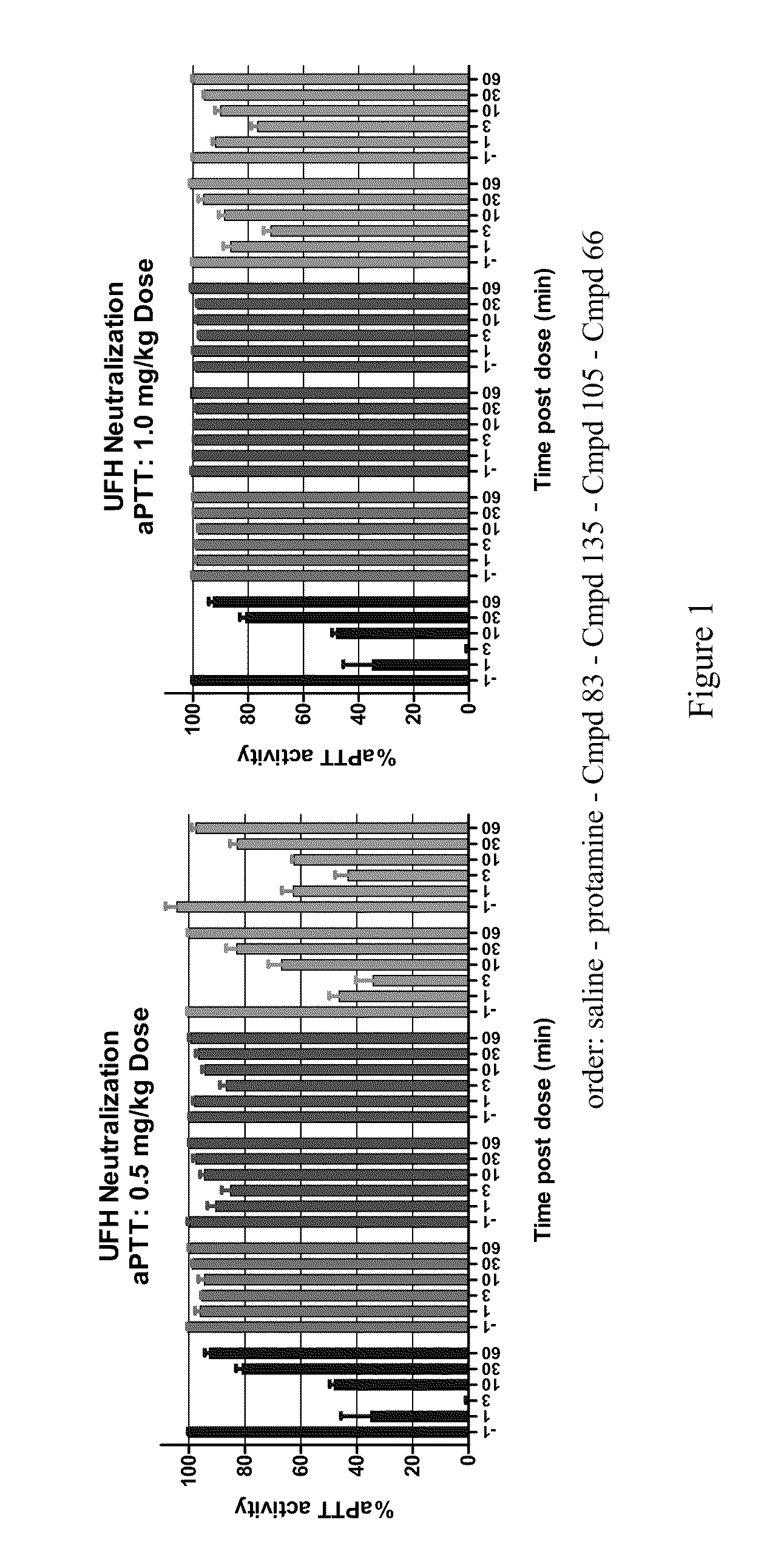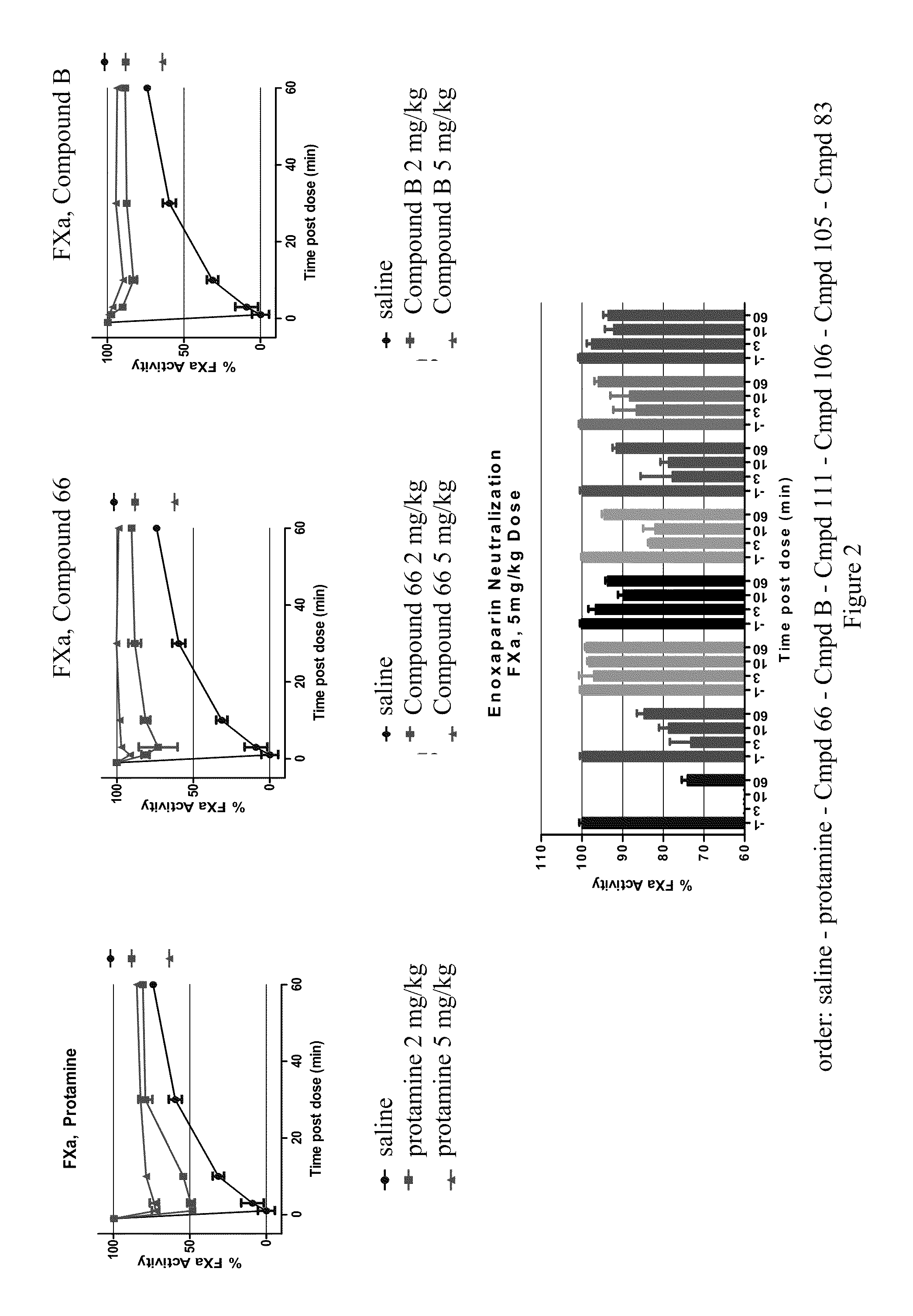Anti-Heparin Compounds
a technology of heparin and compounds, applied in the field of anti-heparin compounds, can solve the problems of poor predictive pharmacokinetic properties, many limitations associated with clinical use, and non-specific protein binding, and achieve the effects of effectively antagonizing unfractionated heparin, effectively antagonizing, and effectively antagonizing
- Summary
- Abstract
- Description
- Claims
- Application Information
AI Technical Summary
Benefits of technology
Problems solved by technology
Method used
Image
Examples
example 1
Synthesis
Synthesis of Compound 1
[0602]
[0603]Step 1: The diacid and dianiline (2 equiv.) were mixed in pyridine, and EDCI was added. The reaction mixture was stirred at room temperature for 24 hours before the solvent was removed. The resulting solid was washed with water and recrystallized in DCM / Hexane.
[0604]Step 2: Product from step 1 and 5-bisBocguanidino pentoic acid were mixed and dissolved in pyridine. The solution was cooled to 0° C. before POCl3 was added to the mixture. The reaction mixture was stirred at 0° C. for 2 hours before it is quenched with ice water. The product was purified by column chromatography.
[0605]Step 3: Product from step 2 was treated with HCl in ethyl acetate for 6 hours. The product was collected by filtration. The purification was done by reverse phase column chromatography.
[0606]Compound 6, 87 and 88 are made by similar procedure using different diacid in the first step.
CompoundDiacids68788
Synthesis of Compound 4
[0607]
[0608]Step 1: A solution of acid...
example 2
Compounds for Evaluation as Anti-Heparin Agents
[0660]The following exemplary compounds (and / or their salts) in Table 1 were prepared by methods such as those reported in U.S. Patent Application Publication Nos. U.S. 2005 / 0287108, U.S. 2006 / 0041023, U.S. Pat. No. 7,173,102, WO 2005 / 123660, WO 2004 / 082643, WO 2006 / 093813, and U.S. patent application Ser. No. 12 / 510,593 filed Jul. 28, 2009.
TABLE 1Compd.No.Structure123456789101112131415161718192021222324252627282930313233343536373839404142434445464748495051525354555657585960616263646566676869707172737475767778798081828384858687888990919293949596979899100101102103104105106107108109110111112113114115116117118119120121122123124125126127128129130131132133134135136137138139140141142143144145146
example 3
FXa Chromogenic Assay (Absence of Plasma)
[0661]Human antithrombin was mixed with an anticoagulant agent (a LMWH or fondaparinux); final concentrations were 0.22 μg / mL for the LMWHs and 0.07 μg / mL for fondaparinux. Different concentrations of a test compound were added (typically 0.07 to 9 μg / mL range) followed by factor Xa and substrate (S-2765). Absorbance was read every 30 seconds over a 4 minute period in a SpectraMax 250 instrument (Molecular Devices, Inc.). EC50 values are determined by a curve-fit program (SoftMax Pro) using the following formula:
P(Cp)=1 / [1+(K / Cp)n]
PUM
| Property | Measurement | Unit |
|---|---|---|
| molecular weight | aaaaa | aaaaa |
| molecular weights | aaaaa | aaaaa |
| v/v | aaaaa | aaaaa |
Abstract
Description
Claims
Application Information
 Login to View More
Login to View More - R&D
- Intellectual Property
- Life Sciences
- Materials
- Tech Scout
- Unparalleled Data Quality
- Higher Quality Content
- 60% Fewer Hallucinations
Browse by: Latest US Patents, China's latest patents, Technical Efficacy Thesaurus, Application Domain, Technology Topic, Popular Technical Reports.
© 2025 PatSnap. All rights reserved.Legal|Privacy policy|Modern Slavery Act Transparency Statement|Sitemap|About US| Contact US: help@patsnap.com



